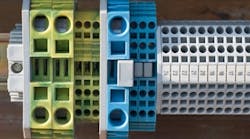Maybe it's just the summer heat, but many formerly solid hardware components seem to be shifting shape and functions like a mirage on a highway. For instance, many terminal blocks appear to be taking on new and surprising jobs, and even recombining functions to meet unexpected requirements.
"We've been seeing innovations for panel optimization, mainly to reduce space, and so we've been developing more industry-specific terminal blocks and sensor blocks," says Jessica Colon, product manager for terminals and marking systems at Rockwell Automation. "For instance, where we used to have three blocks side by side, we now can have two in a line and one on top, which means they take up less space on a DIN rail. Also, where traditional blocks used to be 18 mm, we launched our 10-mm block in November, which is a 45% reduction in size."
SEE ALSO: Terminal Blocks, Connectors and Wire Continue to Evolve and Improve
To preserve even more space and save time, Colon says functions that used to require two or three terminal blocks now can employ just one. "Many sensors have used three-tier, feed-through terminal blocks for 20 years, but for the past few years, fuse blocks with ground connects have been built into terminal blocks."
Michelle Goeman, product manager for rail-mounts, terminal blocks and interfaces at Wago Corp., says more users accept and adopt the spring-pressure technology available in its terminal blocks, and that the resulting time savings and reliable connections inspire developers to implement spring-pressure methods in I/O components, relays, fuse holders and other devices. "In fact, we just introduced our Class CC fuse holder for circuit protection in panels, and it incorporates both spring-pressure and intuitive-lever operation, which shows when the lever opens the spring," Goeman says. "Spring-pressure and its quality connections are expanding to save time in a lot of other markets."
While terminal blocks always will be needed to help deliver power and for field wiring, Howard Minnick, president of Automation Systems Interconnect (ASI), explains that many of their former tasks have been taken over by other devices. "Over the past decade, we and others developed interface modules (IM), field-termination assemblies and transition modules, which can replace rows of terminal blocks with one cable going into a printed circuit board," Minnick says. "This puts the terminal block's functions into wiring on the board or strip, or even onto a cable with a connector. For example, we had a customer making big, PLC-controlled, overhead ventilators, and he had 1½ to 2 feet of terminal and fuse blocks and relays on a DIN rail. We replaced them with an IM that combined the fuses, relays and connectors, snapped them onto the DIN in one piece, and cut his space used by 50%."
Minnick confirms that two-level terminal blocks with a fuse on top to protect current have spun off and joined three-level blocks with one wire going in, which replace the three side-by-side blocks with separate wires that used to serve devices like three-wire sensors. "Then, sensors gained programmability, and so now we have four-level terminal blocks, which grow out into the available depth in their cabinets."
Vince Lucci, product manager at c3controls, agrees. "Everyone's working out how to make terminal blocks smaller, and fit them into specific applications such as ATEX," he says. "These days we see terminal block systems with really clever interfaces, which are designed specifically to connect to I/O and PLCs. Instead of stacking a couple of blocks together, you now see some machines with dedicated, multi-block systems with specialized marking and jumper straps and accessories. Clearly, the availability of new materials drives these trends. For instance, characteristics of advanced, engineered thermoplastics allow us to fabricate terminal blocks with thinner walls, which can handle higher-rated currents in smaller packages."
Matt Boudjouk, product manager in the I/O and networking division at Turck, adds that, as terminal blocks or equivalents are implemented in new settings, many are finding they need IP67 and other types of protection. "Once you get outside the panel or no longer need conduit, then you're likely to need molded cables and connectors, and so a lot of terminal blocks need IP67 protection, too," Boudjouk says. "For example, our Block I/O station has fixed IP67 modules, and can bring I/O or 4-20 mA signals right into the block, while our BL67 modular I/O is more flexible than a terminal block, and operates like the rack I/O on a machine. In fact, next year we're going to introduce an IP67 PLC for total control outside the cabinet."






